3.2.1 Compartment size - floor area & cubical extent
E
Explanations & Illustrations
Clause 3.2.1 : Compartment size - floor area & cubicle extent
Generally, the compartment size of apartment or maisonette unit would not exceed 4000m² or a cubical extent of 15000m³ as given in Table 3.2A which is reproduced below:
| 3.2A : SIZE LIMITATION OF BUILDING & COMPARTMENT |
| Compartments |
Maximum Floor Area |
Maximum Cubical Extent |
Compartment below ground level
(No compartment shall comprise more than one storey) |
2000m² |
7500m³ |
Compartments between average ground level and a height of 24m
(No compartment shall comprise more than 3 storeys) |
4000m² |
15000m³ |
Compartments above a height of 24m from average ground level
(No compartment shall comprise more than one storey) |
2000m² |
7500m³ |
However, for non-residential areas in buildings under PG II, such as communal area or car parking area irrespective of location in either upper storeys or basement, there would be a need to apply the size limitation of 4000m² or 15000m³. The
above non-residential areas would be dealt with under their respective PG VII & VIII respectively.
Compartment below ground level
1. Under Table 3.2A no compartment shall comprise more than one storey and exceed floor area of 2000m² and a cubical extent of 7500m³. However, exceptions are allowed in the following situations:
a. Only 1st basement having a floor area of less than 100m² can form part of the 1st and upper storey compartment under Cl.3.2.5c., provided the building is sprinkler-protected including the basement.
b. Basement floors can be interconnected for use as car parking, if sprinkler system is provided.
2. Basement floor or compartment shall not be used for bulk storage of highly inflammable liquids or substances of any explosive nature.
Compartments between average ground level & a height of 24m
No compartment shall comprise more than 3 storeys and floor area greater than 4000m² and cubical extent exceeding 15000m³. However, exceptions are allowed under Cl.3.2.3, Cl.3.2.4a. and Cl.3.2.8.
Compartments above a height of 24m from averaged ground level
1. No compartment shall comprise more than 3 storeys and floor area greater than 4000m² and cubical extent exceeding 15000m³. Every storey above a height of 24m shall be a fire compartment.
General: In computing the extent of a compartment, protected shafts e.g. lift, staircases etc. and separately compartmented lavatory/locker room can be disregarded. See Cl.1.4.29 for further illustration.
2. High bay warehouse (HBW) and mechanised car parking buildings are treated differently from normal industrial buildings.
The requirement of restricting the compartment to max. 3 storeys would not be applicable. Such types of buildings are usually not occupied or have very limited people working in the premises.
Automatic sprinkler system and smoke extraction or venting system are required to be provided for high bay warehouses and mechanised car parking buildings which exceed 24m in building height.
Compartments above a height of 24m from averaged ground level
No compartment shall comprise more than one storey and exceed the floor area of 2000m² and cubical extent of 7500m³.
This requirement would not apply to high bay warehouses and mechanised car parking buildings. Prior consent is to be obtained from the SCDF before submission of building plan.
Any building other than a building of PG I which has any storey the floor area of which exceeds that specified as relevant to a building of that height in column (2) of Table 3.2A, or a cubic capacity which exceeds that specified as relevant in column (3) of Table 3.2A, shall be divided into compartments by means of compartment walls and compartment floors so that:
a. no such compartment has any storey the floor area of which exceeds the area specified as relevant to the building in column (2) of the table; and
b. no such compartment has a cubic capacity which exceeds that specified as relevant in column (3) of the table.
3.2.2 Cubical extent for compartment exceeding 4m in height
a. In computing the cubical extent of compartments in single storey buildings such as factories, sport halls, markets, food courts, multi-purposes halls, cinemas, concert halls, churches, temples and similar buildings, the height of 4m shall be used where the actual height exceeds that figure.
b. If any compartment comprises more than one storey or contains mezzanine, galleries or lofts, the full height of the compartment shall be used in computing the cubical extent for each storey, mezzanine, galleries or lofts.
R
Rationale - Clause 3.2.2
The 4m in height serve as a relaxation for purpose of computing cubical extent, instead of using the actual height, for single storey buildings of non-warehouse usage. The consideration takes into account that such spaces are meant to facilitate placement of machinery and for purpose of viewing, and are unlikely to have high level storage.
c. Where two buildings are connected by external open-sided covered walkway or open-sided covered link-bridge, the buildings are considered as separate buildings, if they comply with the following conditions:
(1) There is no commercial activities or other usage that would pose a fire risk within the covered walkway or link-bridge.
(2) The width of the covered walkway or covered link-bridge shall not exceed 5m measured from eave to eave.
3.2.3 Exemption of compartmentation
E
Explanations & Illustrations
Clause 3.2.3 : Exemption of compartmentation
( No illustration )
To avoid providing fire compartmentation in building to comply with the cubical extent and floor area control under Table 3.2A,
automatic sprinkler system would be proposed as an alternative. Where automatic sprinkler system is to be provided to a building, compliance with Table 3.2A on max 3 storeys per compartment is still required, unless atrium design is proposed subject to obtaining the SCDF ’s prior approval before submission of
building plan.
!
Note to QPs on Clause 3.2.3
QPs should consult SCDF for all atrium designs. Requirements provided under Cl.7.5, Cl.3.2.6, Cl.3.2.4 and Cl.9.8.3 are to be complied with respectively.
Cl.3.2.1 is not applicable if the building:
a. is fitted throughout with an automatic sprinkler system which complies with the requirements in Chapter 6; and
b. complies with Cl.3.2.4, Cl.3.2.6, Cl.7.4 and Cl.9.8.3.
3.2.4. Compartmentation by height
a. In any compartment except those mentioned under Cl.9.1, up to a habitable height of 24m, no compartment shall comprise more than three storeys. This
requirement can be relaxed for atrium spaces provided the design of such spaces complies with the conditions stipulated under Cl.3.2.6.
E
Explanations & Illustrations
Clause 3.2.4a. : Compartmentation by height
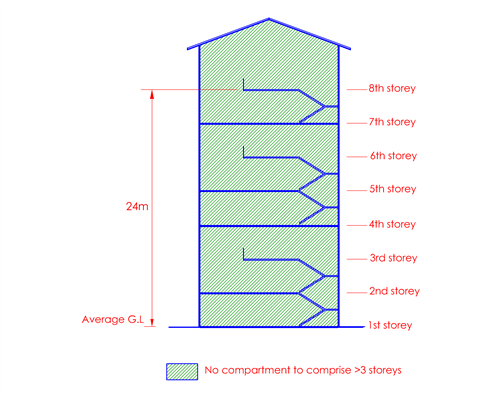
Figure 3.2.4a.
Where 3 storeys or levels form one compartment, the total floor area shall not exceed 4000m² and the total cubical extent shall not exceed 15000m³, subject to compliance with travel distance requirements under Chapter 2.
In the case of atrium design space, it can go beyond 3 storeys per compartment but shall not exceed habitable height of 24m. in other words, every storey beyond 24m in height is a fire compartment.
b. In any building which exceeds 24m in habitable height, no compartment shall comprise more than one storey for compartments at storey level exceeding 24m above average ground level, other than a compartment which is within a residential maisonette which may comprise two storey levels.
E
Explanations & Illustrations
Clause 3.2.4b. : Compartmentation by height
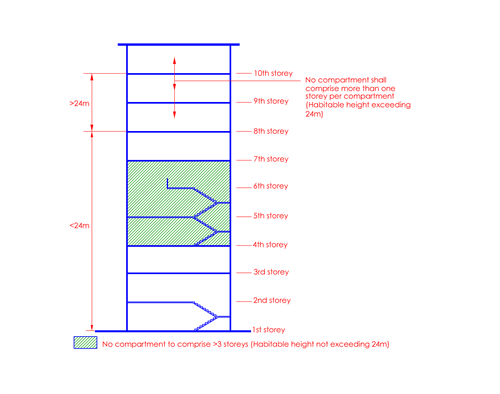
Figure 3.2.4b. - 1
In any commercial building which exceeds 24m in habitable height, no compartment shall comprise more than one storey per compartment from storey level exceeding 24m above average ground level. There is a need to keep the fire compartment size small within 2000m² or 7500m³ above that habitable height, as it would otherwise pose difficulties to firefighting and control of fire spread should there be a fire occurrence in one of those high-rise units.
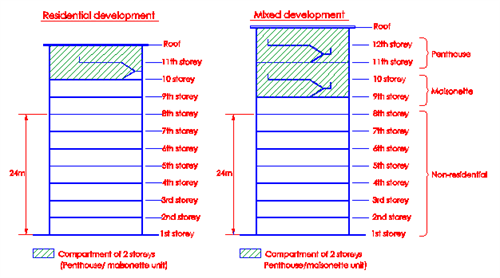
Figure 3.2.4b. - 2
In any residential building which exceeds 24m in habitable height, no compartment shall comprise more than one storey per compartment from storey level exceeding 24m above average ground level. However, for residential maisonette or penthouse unit, maximum two storey levels are allowed to form one compartment. This should be taken as a relaxation. There is a need to keep the fire compartment size small within 2000m² or 7500m³ above that habitable height as it would otherwise pose difficulties to fire fighting and control of fire spread should there be a fire occurrence in one of those high-rise units. In situation where there are maisonette or penthouse units located in non-residential building, fire protection/detection system applicable to the building shall be extended to cover the residential units.
3.2.5 Areas requiring compartmentation
The following situations shall require compartmentation by provision of compartment walls and/ or compartment floors:
a. PG II buildings
Any wall and floor separating a residential apartment or maisonette from any other part of the same building, unless permitted (as in the case of an external wall adjoining an external corridor, for provision of window openings).
E
Explanations & Illustrations
Clause 3.2.5a. : Areas requiring compartmentation
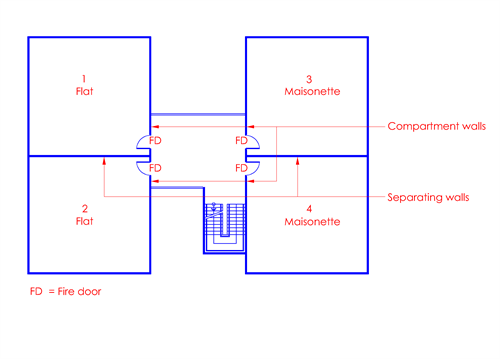
Figure 3.2.5a. - 1 : Compartment walls in PG II building
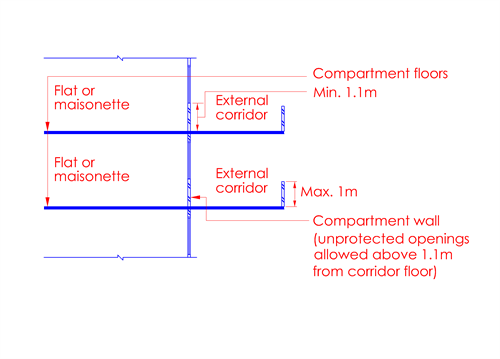
Section
Figure 3.2.5a. - 2 : Compartment walls & floors in PG II building
b. Areas of different purpose groups
Any wall and floor separating part of a building from any other part of the same building which is used or intended to be used mainly for a purpose falling within a different purpose group, as identified under Table 1.4A, except the following:
(1) ancillary offices located within a building or compartment of PG III, V, VI, VII and VIII, or
(2) rooms or spaces for ancillary usage located within a building or compartment of PG III to VIII as stipulated under Cl.1.4.5, or
(3) rooms or spaces located within a sprinkler-protected building, unless otherwise stated in following Cl.3.2.5 or other clauses in the Code.
E
Explanations & Illustrations
Clause 3.2.5b. : Areas requiring compartmentation
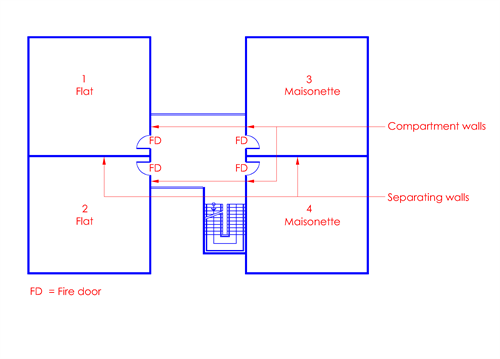
Figure 3.2.5b. - 1 : Compartment walls separating different PGs
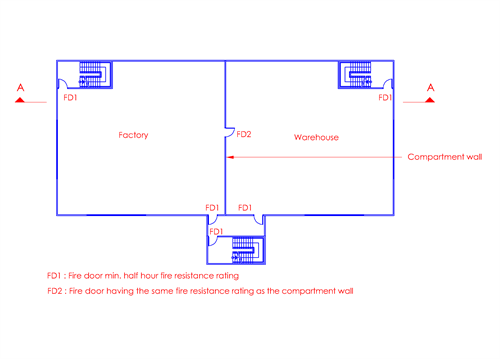
Figure 3.2.5b. - 2 : Compartment walls separating different PGs
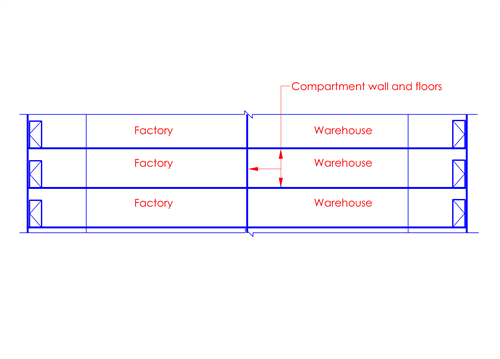
Figure 3.2.5b. - 3 : Compartment walls & floors separating different PGs
Compartment walls and floors shall be constructed of non-combustible materials to have minimum 1-hr fire resistance rating under
Table 3.3A for any of the compartment.
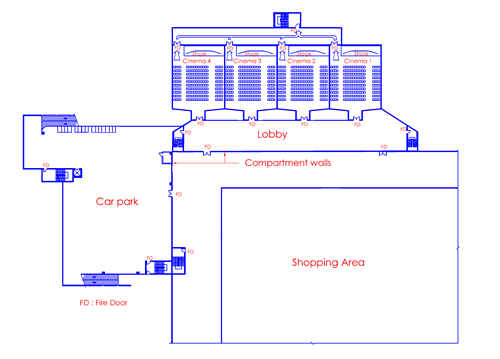
Figure 3.2.5b. - 4 : Compartment walls separating different PGs
In the above diagram, the car park (PG VIII) is fire compartmented from the shopping area. The car park has higher fire risks than shopping and cineplex. Fire separation between cineplex and shopping area is required. This is to safeguard the occupants
in the cineplex from any fire occurrence in the shopping area.
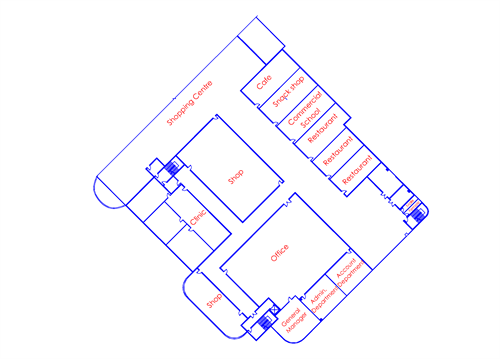
Figure 3.2.5b. - 5 : A mixture of different PGs without fire compartment
The above diagram shows a typical shopping floor, which has a mixture of different purpose groups without fire compartmentation.
Strictly interpreting the above subclause would mean that in a shopping centre, for example, shop (PG V), office (PG IV), place of public resort (PG VII), commercial school (PG III) would need to be separately compartmented from each other. This would
not be practical. In practice, shopping or commercial buildings would have mixture of the uses of different purpose groups.
Under sub-clause (b)(i), an ancillary office which is located within the compartment or floor used as PG V is not required to be separately fire compartmented, provided the measurement of travel distance requirements of PG III shall apply to the ancillary
office. Similarly, under sub-clause (b)(ii) , ancillary usage to PG III such as sick/first aid room, reception lobby/area, waiting area, staff lounge/staff recreation room, staff rest room/pantry, staff changing/locker room, meeting room, staff training
room, etc. is not required to be separately fire compartmented.
c. Floor over a basement
Any floor immediately over a basement for PG II to VIII buildings shall be a compartment floor except for:
(1) a basement with floor area not exceeding 100m², or
Effective Date: 25 Aug 2023
Amendment History
| 3.2.5c. |
25 Aug 2023 |
25 Aug 2023 |
Revised/Clarifications |
3.2.5c. Floor over a basement
Any floor immediately over a basement storey if such storey:
(1) forms part of a building or compartment of PG II to VIII, or
(2) has an area exceeding 100m² except that in the case of a building or compartment of PG IV, V and VII, the SCDF can consent to exemption from the above requirements provided:
(a) the building is fitted throughout with an automatic sprinkler system in compliance with the requirements in Chapter 6; and
(b) if the building comprises more than one basement storey, the floor at first basement storey level is constructed as a compartment floor. |
25 Aug 2023 |
Download
|
(2) PG IV, V and VII buildings with basement floor area exceeding 100m2, provided the following conditions are complied with:
(a) the building is fitted throughout with an automatic sprinkler system in compliance with the requirements in Chapter 6; and
(b) the first basement shall be compartmented from other basement storeys.
Note: For PG I buildings, refer to Cl.9.1.1b.(2) for compartmentation of floor over basement requirements.
E
Explanations & Illustrations
Clause 3.2.5c.(2) : Areas requiring compartmentation
( No illustration )
To avoid providing fire compartmentation in building to comply with the cubical extent and floor area control under Table 3.2A,
automatic sprinkler system would be proposed as an alternative. Where automatic sprinkler system is to be provided to a building, compliance with Table 3.2A on max 3 storeys per compartment is still required, unless atrium design is proposed subject to obtaining the SCDF ’s prior approval before submission of
building plan.
-1.tmb-firecode.png?Culture=en&sfvrsn=be3082c4_1)
Figure 3.2.5c.(2) - 1 : Floor over basement
Where the floor area of the basement exceeds 100m2 it shall be a compartment below ground level and shall not comprise more than one storey. The basement floor shall be provided with sprinkler system under Cl.6.4.1d.(1) and dry riser under Cl.6.2.1b.
-2.tmb-firecode.png?Culture=en&sfvrsn=e16108fe_1)
Figure 3.2.5c.(2) - 2 : Floor over basement
In situation where the basement floor area is not exceeding 100m², the basement and upper storeys may be allowed to be interconnected to form one compartment, subject to max. 3 storeys or levels in a single compartment. It should be noted
that Cl.3.2.5d. prohibits more than one storey below ground level to be connected to form one compartment.
-3.tmb-firecode.png?Culture=en&sfvrsn=9c7ad0f2_1)
Figure 3.2.5c.(2) - 3 : Floor over basement
All basement floors, except those under PG I & II, are required to be provided with automatic sprinkler system under Cl.6.4.1d.(1). Where basement floor, regardless of its area, is interconnected with upper storeys, the automatic sprinkler system required for the basement shall be extended to cover all the upper storeys.
-4.tmb-firecode.png?Culture=en&sfvrsn=124fe5f4_1)
Figure 3.2.5c.(2) - 4 : Floor over basement
For buildings under PG IV, V and VII, the first basement floor can be inter-connected with the upper storeys regardless of whether or not it exceeds 100m2, provided sprinkler system and smoke control system are provided.
For atrium design, prior consent from the SCDF should be obtained before making Building Plan submission. See Cl.3.2.4a..
Cl.3.2.5d. prohibits more than one basement floor to be connected to form one compartment, except in the case
of basement used solely for car parking.
d. Basement floors
In any compartment below pavement level, no compartment shall comprise more than one storey, except in the case of PG IV, V and VII buildings as permitted under Cl.3.2.5c.(2) and in the case of basement used solely for car parking. No part of a basement storey shall be
used for the bulk storage of highly inflammable liquids or substances of an explosive nature.
E
Explanations & Illustrations
Clause 3.2.5d. : Areas requiring compartmentation
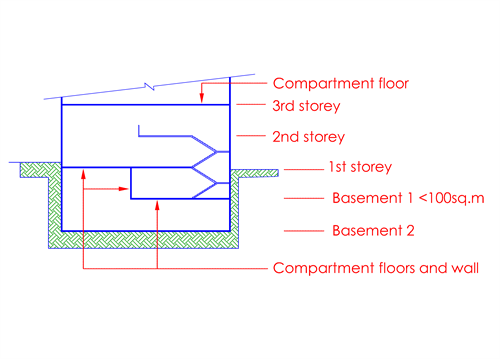
Figure 3.2.5d. - 1
Basement 1, which has a floor area of less than 100m² can be interconnected with 1st storey, provided it is compartmented from basement 2. Sprinkler system and rising mains are required to be provided to the building.
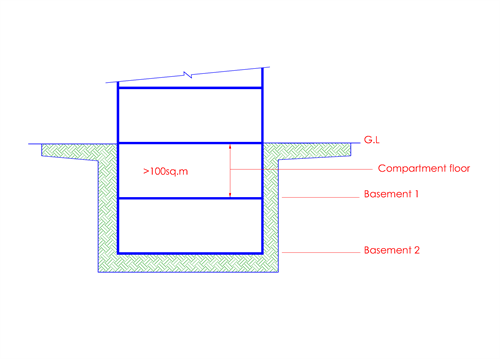
Figure 3.2.5d. - 2
Basement 1 having a floor area of more than 100m² is required to be compartmented from 1st storey. The above clause does not permit more than one basement storey per compartment unless solely used for car parking. Sprinkler system and rising
main are required to be provided to basement.
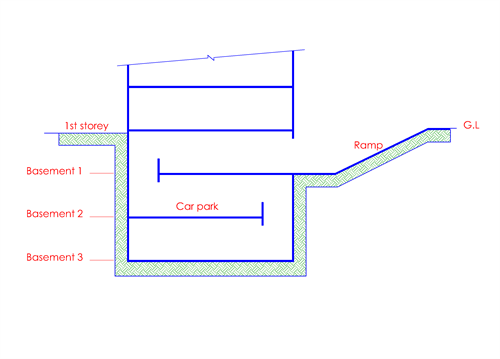
Figure 3.2.5d. - 3
Owing to the special use where ramps or car lifts are needed to connect all the floors, compartmentation is relaxed where sprinkler system and rising main are provided.
e. Fire Command Centre (FCC)
The FCC shall be separated from other parts of the same building by compartment walls and floors having at least 2-hr fire resistance rating.
E
Explanations & Illustrations
Clause 3.2.5e. : Areas requiring compartmentation
( No illustration )
The fire resistance rating of the walls and floors shall comply with the elements of structure and shall have minimum period of 2 hours. Any door opening into the Fire Command Centre from the occupancy area shall be minimum 2-hr fire-rated.
f. Kitchen
In room/ space where open-flame cooking activities are carried out, except for residential units in PG I and II buildings, the following requirements shall be complied with:
Effective Date: 25 Aug 2023
Amendment History
| 3.2.5f. |
25 Aug 2023 |
25 Aug 2023 |
Revised/Clarifications |
3.2.5f. Kitchen
In an eating establishment where a kitchen is required for the preparation of food and where open-flame cooking appliances are used, the following requirements shall be complied with:
(1) ………… |
25 Aug 2023 |
Download
|
| 4.2.3f. |
25 Aug 2023 |
25 Aug 2023 |
Revised/Clarifications |
4.2.3f. Exemption
The provision of fire access openings shall not be applicable to buildings under PG I and II, including building of non-residential ancillary usage (such as gyms, club rooms, etc.) in a residential building. |
25 Aug 2023 |
Download
|
(1) The kitchen shall be separated from other parts of the same building by compartment wall and floor having at least 1-hr fire resistance rating. Separation requirement for kitchen can be exempted under the following conditions:
R
Rationale - Clause Clause 3.2.5f.(1)
The conditions for exemption of compartmentation for open-flame cooking area ensure that smoke could be readily dispersed via the openings to the external and fire can be contained within the cooking area so as not to affect the escape of occupants.
E
Explanations & Illustrations
Clause 3.2.5f.(1) to (3) : Areas requiring compartmentation
-(3)-1.tmb-firecode.png?Culture=en&sfvrsn=a68cb071_1)
Figure 3.2.5f.(1) to (3) - 1
The above figure illustrates a eating establishment without kitchen fire-suppression system. The clause enables the QP to exercise the option of compartmenting kitchen with open-flame cooking.
-(3)-2.tmb-firecode.png?Culture=en&sfvrsn=310b5415_1)
Figure 3.2.5f.(1) to (3) - 2
Kitchen is compartmented from dining area by 1-hr enclosures and ½-hr fire doors. Protection to servery hatch can be a fire-rated roller shutter held in the open position by fusible links.
-(3)-3.tmb-firecode.png?Culture=en&sfvrsn=f0cb00c3_1)
Section
Figure 3.2.5f.(1) to (3) - 3
As the dumb waiter is connecting 2 storeys, it shall be enclosed in 2-hr protective enclosures with 1-hr fire-rated access door at each storey.
(a) when all the cooking facilities in the kitchen are fitted with approved extinguishing systems, or
E
Explanations & Illustrations
Clause 3.2.5f.(1)(a) : Areas requiring compartmentation
(a).tmb-firecode.png?Culture=en&sfvrsn=83a62b19_1)
Figure 3.2.5f.(1)(a)
The above sub clause allows the kitchen not to be compartmented if the cooking hood or range is installed with an automatic fire suppression system. Automatic fire suppression system shall be of approved type based on international standards such as NFPA 17A. QPs are also reminded to ensure that the premise owners/ operators are aware of the stipulated maintenance regime in the standards.
With this arrangement, there is no need to seek waiver approval from the SCDF.
(b) when there are at least 25% of the perimeter walls (excluding air well and void) of an eating establishment open directly to the external of the building, and provided any part of the floor space is within 9m from the nearest opening, or
E
Explanations & Illustrations
Clause 3.2.5f.(1)(b) : Areas requiring compartmentation
(b)-1.tmb-firecode.png?Culture=en&sfvrsn=2737740e_1)
Figure 3.2.5f.(1)(b) - 1
(b)-2.tmb-firecode.png?Culture=en&sfvrsn=f679ce39_1)
Figure 3.2.5f.(1)(b) - 2
(b)-3.tmb-firecode.png?Culture=en&sfvrsn=44f5a53e_1)
Figure 3.2.5f.(1)(b) - 3
(c) when there are at least 50% of the perimeter walls (excluding air well and void) of an eating establishment open directly to the external of the building, and provided any part of the floor space is within 12m from the nearest opening, or
E
Explanations & Illustrations
Clause 3.2.5f.(1)(c) : Areas requiring compartmentation
(c)-1.tmb-firecode.png?Culture=en&sfvrsn=f31a6395_1)
Figure 3.2.5f.(1)(c) - 1
(c)-2.tmb-firecode.png?Culture=en&sfvrsn=c16d5fd4_1)
Figure 3.2.5f.(1)(c) - 2
The 25% and 50% ventilation openings are required for smoke venting and relief of accumulated heat from the area on fire. This exemption cannot be applied in an enclosed air-conditioned environment, where the peripheral walls are fitted with glass
panel.
The 25% and 50% ventilation openings are absolute values. Extrapolation of percentage ventilation openings based on depth of the eating establishment is not permitted.
(c)-3.tmb-firecode.png?Culture=en&sfvrsn=7b58a48c_1)
Figure 3.2.5f.(1)(c) - 3
In the above figure the kitchens are not required to be compartmented.
Ventilation openings along the external walls ‘a’, ‘b’, ‘c’ and ‘d’ shall be uninterrupted, having minimum 50% of the perimeter walls of the eating establishment. The openings to the air well
shall not be included in this purpose.
The above requirement is more relevant to hawker centre type design.
(d) when an eating establishment is separated from other parts of the same building by walls and floors having 1-hr fire resistance rating and doors having at least ½-hr fire resistance rating; and provided:
(i) for a sprinkler-protected building, there is no restriction to the floor area of the compartment, or
(ii) for a non-sprinkler-protected building, the floor area of the compartment shall not exceed 150m2.
(2) Openings in the compartment wall and floor shall comply with the relevant provisions of Cl.3.9 for
protection of openings.
(3) Doors shall have at least ½-hr fire resistance rating and be fitted with an automatic self-closing device.
E
Explanations & Illustrations
Clause 3.2.5f.(1)(d) : Areas requiring compartmentation
(d)-1.tmb-firecode.png?Culture=en&sfvrsn=98468b6e_1)
Figure 3.2.5f.(1)(d) - 1
Under Cl.3.2.5f.(1)(d)(i), the kitchen and dining area can be in one compartment, provided the building is sprinkler-protected
and there is no need restricting to the floor area of the compartment
(d)-2.tmb-firecode.png?Culture=en&sfvrsn=66919709_1)
Figure 3.2.5f.(1)(d) - 2
With the provision of sprinkler system, further relaxation is allowed to permit the whole eating establishment to be enclosed with at least 1-hr fire-rated walls and ½-hr fire-rated door. There is no restriction to the accessible floor
area of the eating establishments.
(d)-3.tmb-firecode.png?Culture=en&sfvrsn=16e9482e_1)
Figure 3.2.5f.(1)(d) - 3
Under Cl.3.2.5f.(1)(d)(iI) where the building is not sprinkler-protected, the area of the compartment, kitchen
and dining area e.g. (unit A) shall not exceed 150m2.
(4) Where the flue or duct passes through the compartment wall or floor, the flue or duct shall be encased by non-combustible construction to comply with the requirements of Cl.3.9.5, and the installation of dampers in such flue or duct is prohibited.
(5) LPG cylinders provided for open-flame cooking activities shall not be located at the basement and the installation of LPG cylinders at other areas shall comply with the provisions in the Fire Safety (Petroleum) Regulations.
E
Explanations & Illustrations
Clause 3.2.5f.(4) : Areas requiring compartmentation
.tmb-firecode.png?Culture=en&sfvrsn=815f975e_1)
Section
Figure 3.2.5f.(4)
Kitchen is required to be compartmented from other areas by 1-hr compartment walls and floors. Doors to the kitchen shall have minimum ½-hr fire resistance rating and shall open outward from the kitchen. Small fires which commonly occur in the
kitchen are often caused by overheating of cooking oil on the stove or in a deep pan fryer or by grill. Exhaust ducts in kitchen are usually coated with grease internally over a period of time. Fire in the ducts could be started by sparks or by fire
from the stove.
Cooking appliances include – open-flame gas fired oven, charcoal grill and appliances which have open flames located or protected from views.
Fire-rated door to kitchen shall not be wedged open for serving purpose. In circumstances where fire doors are to be kept open, the door shall be fitted with electromechanical device susceptible to smoke under Cl.3.9.2c.. See Cl.1.4.34 for further illustration.
To qualify for non-provision of fire compartment under Cl.3.2.5f.(1), auto fire suppression equipment should be incorporated
into the cooking range. This equipment may consist of fixed pipe carbon dioxide, dry chemical or foam- water sprinkler or spray system. Such auto suppression system to the cooking range shall be listed and approved by a certification body.
Notwithstanding all the above, the compartment where open-flame cooking activities is carried out shall not comprise more than one storey.
E
Explanations & Illustrations
Clause 3.2.5f. : Areas requiring compartmentation
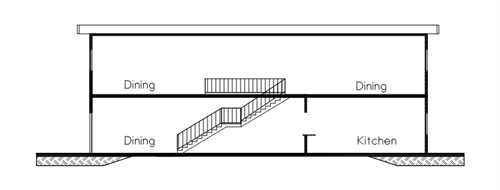
Section
Figure 3.2.5f.
Where ‘open-flame’ cooking is used, the compartment comprising dining and kitchen areas shall not comprise more than one storey:
In the case of eating establishment which comprises 2 storeys, then each storey shall be a fire compartment by itself.
g. Motor vehicle workshop
A motor vehicle workshop shall be separated from any other part of the same building by compartment walls and floors having at least 2-hr fire resistance rating, and if located in a basement storey of a building, shall be separated from any other part of the same building by compartment walls and floors having at least 4-hr fire resistance rating.
E
Explanations & Illustrations
Clause 3.2.5g. : Areas requiring compartmentation
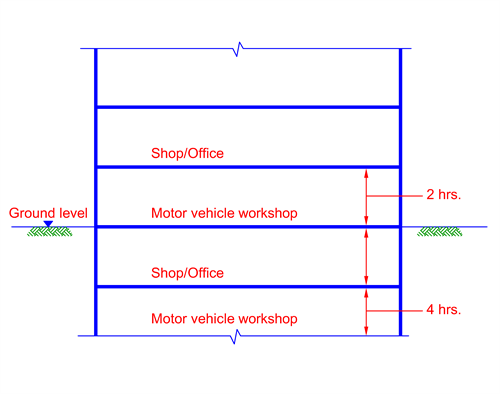
Section
Figure 3.2.5g.
h. Spray painting room
Areas in which spray painting or other related processes are performed or carried out, shall be separated from other parts of the same building by compartment walls and floors having at least 2-hr fire resistance rating. Where spray painting booths that have built-in vapour extraction system complying with NFPA 33, the fire resistance requirement is not applicable.
Where a spray painting room or booth is protected by an automatic sprinkler system but not complying with NFPA 33, the fire resistance rating for the fire compartment to the room or booth can be reduced from 2-hr to 1-hr.
E
Explanations & Illustrations
Clause 3.2.5h. : Areas requiring compartmentation
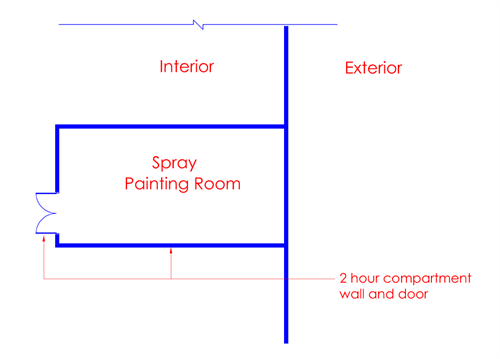
Figure 3.2.5h.
Spray painting booth or room shall be mechanically ventilated and enclosed in min. 2-hr fire-rated compartment to allow spraying of paint to be carried out. It shall be constructed to prevent the escape of spray and flammable vapour which shall be removed by the exhaust system.
The exhaust discharge point shall be not less than 5m from the inlet of any mechanical ventilation system.
i. Store room
For non-sprinkler-protected buildings, if the area of the store room exceeds 10m², it shall be compartmented from the other parts of the same building by compartment walls and floors having at least 1-hr fire resistance rating. No fire compartmentation
is required for a store room which is housed within a sprinkler-protected building. However, store room exceeding 700m2 and 100m2 for above-ground and below-ground respectively are subject to the compartment size requirements
stipulated under Cl.9.8.3.
E
Explanations & Illustrations
Clause 3.2.5i. : Areas requiring compartmentation
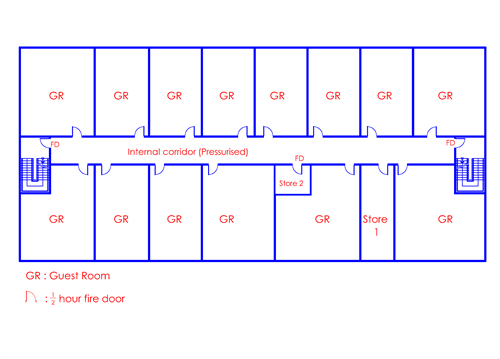
Figure 3.2.5i.
Store 1 exceeding 10m² inside a Hotel space will need to be compartmentalised with 1- hour fire rated enclosures.
Store 2 which is less than 10m² still required to be provided with fire door as the store opens into internal corridor, which is pressurised.
The main reason for compartmentation of storeroom is to prevent undetected fire in the storeroom from developing into a big fire.
Compactus
Compactus room which is more than 10m² shall be treated as a compartment under the above sub-clause. The enclosing walls/floor/ceiling/door shall have min. 1-hr fire resistance rating. Irrespective of the location of the compactus storage area, if it is not enclosed in a room, it shall be treated as open storage shelves and not as a store. The main reason is that a fire occurring in a room could be unnoticed, until it becomes too big to be put out by first aid firefighting equipment. An incipient fire occurring in an unenclosed compactus storage area could be easily spotted by occupants and immediate reaction could be taken to put out the fire.
Any store, regardless of its size, shall be compartmented under the above sub-clause if it opens directly into exit passageways and designated protected escape routes, e.g. smoke-stop lobbies, protected staircases.
j. Areas of special hazard
(1) Areas of special high risk in a building
Boiler rooms, transformer rooms, generator rooms, storage areas of materials that are highly combustible or flammable, and any other areas of special high risk shall be separated from other parts of the building by compartment walls and floors having at least 2-hr fire resistance rating. If the building is protected by an automatic sprinkler system, the fire resistance rating of the compartment walls and floors can be reduced to one hour.
E
Explanations & Illustrations
Clause 3.2.5j. : Areas requiring compartmentation
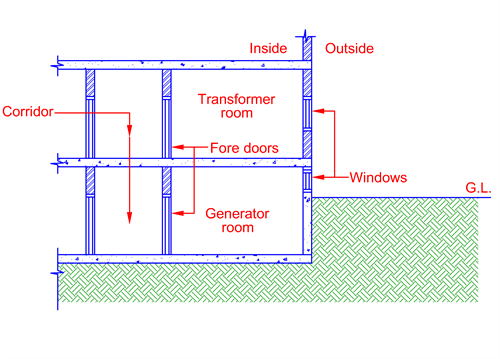
Section
Figure 3.2.5j.
Transformer and generator rooms that contain flammable liquids should be located against an external wall for external ventilation and explosion relief.
Transformer room
Transformers could be dry type or oil cooled type. Oil cooled type is to be located against an external wall above ground level to allow for external ventilation and explosion relief. Adequate precautions should be taken by the provision of a suitable catch pit or other means to prevent the spread of fire resulting from leakage and ignition of oil.
Generator rooms
Generator sets shall be located in clean, dry locations within fire-rated compartments. They may be placed outdoors if they are of purpose built type, provided proper separation from unprotected openings of the building is maintained. Generator rooms shall be located against an external wall above ground level to allow for external ventilation and explosion relief.
Storage areas of highly combustible or flammable materials
Where possible, oil storage tanks should be installed in open air at ground level at least 6m from adjacent buildings and in accordance with CP 40. A max. capacity of 700 litres of diesel oil is permitted to be stored in the generator room. The oil drum(s) shall be located within a bunded area, capable of containing 100% spillage from the drum(s).
Prior approval is to be obtained from the SCDF for storage of combustible or flammable liquids, other than in the generator room, before building plan submission.
(2) Room housing transformer that uses flammable liquid shall be located at ground level against an external wall.
R
Rationale - Clause 3.2.5j.(2) & (3)
Rooms for housing dry transformer, transformer using non-flammable liquids or generator needs not be located against an external wall.
Diesel fuel tank within a generator room is also not required to be placed against an external wall as the flash point of diesel fuel is high enough to be. non-flammable in most environments. However, it still required careful storage and safety precautions.
(3) Diesel fuel tank for generator need not be located against an external wall.
3.2.6 Provision for atrium spaces
E
Explanations & Illustrations
Clause 3.2.6 : Provision for atrium spaces
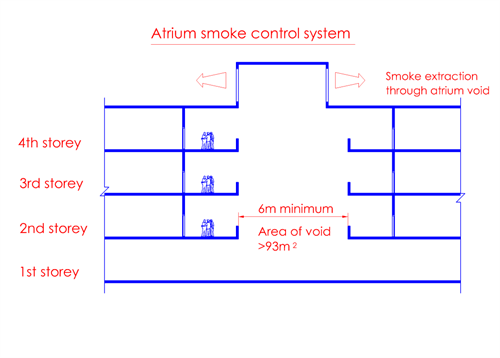
Section
Figure 3.2.6 - 1
1. The above clause allows the SCDF to vary the max. floor area/cubical extent of fire compartment to allow more than 3 storeys to be interconnected. The critical points for consideration would include the size and configuration of atrium void
and the provision of sprinkler system and engineered smoke control system.
2. QPs should consult the SCDF in cases of all atrium designs before making building plan submission. The vetting will confine only to looking at the concept and the layout and profile of atrium void in the building proposal only. Calculations
for the engineered smoke control system shall be submitted separately by M&E QPs.
3. Where a compartment in a building has a total floor area and cubical extent greater than that allowed under Table 3.2A,
but the number of floor interconnected by void does not exceed 3 floors, QPs should consult the SCDF whether there is a need to provide engineered smoke control system, before making building plan submission. Similarly, if a compartment in a building
has a total floor area and cubical extent greater than that allowed under Table 3.2A and the number of floor interconnected by void is more than 3 floors, QPs should consult the SCDF before making building plan submission. The consultation would confine to vetting of requirements mentioned in sub-clause 2. above.
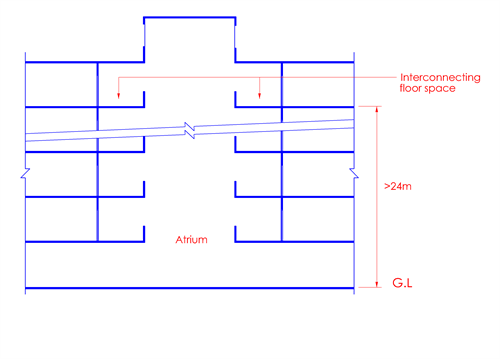
Section
Figure 3.2.6 - 2
Atrium design allows multiple floors to be connected beyond 3 storeys per compartment but limit to a habitable height of 24m. The design would require the provision of engineered smoke control system and sprinkler system. The above clause
allows atrium design in buildings, but prior approval from the SCDF must be obtained before building plan submission can be made. See Cl.1.4.13.
Amendment History
| 3.2.6 |
25 Aug 2023 |
25 Aug 2023 |
Revised/Clarifications |
3.2.6 Provision for atrium spaces
The SCDF can consent to modify the requirements under Cl.3.2.1 and Cl.3.2.4a. of this Code for the design of atrium spaces in a building provided all the following conditions are complied with:
a. …………….
b. Occupancy within the floor space of the atrium meets with the specification for low or ordinary hazard content. |
25 Aug 2023 |
Download
|
The requirements of Cl.3.2.1, Cl.3.2.4a. and Cl.3.2.4b. of this Code are not applicable for atrium spaces provided the following conditions are complied with:
a. The minimum plan area of the atrium void shall be not less than 93m² and no horizontal dimension between opposite edges of the floor opening is less than 6m wide.
b. The atrium space is not of high hazard occupancy as stated in Cl.1.4.68.
c. The atrium is open and unobstructed in a manner such that it can be assumed that a fire in any part of the space will be readily obvious to the occupants before it becomes a hazard.
d. The building is fitted throughout with an automatic sprinkler system to comply with the requirements in Chapter 6.
e. The building is fitted with an engineered smoke control system in accordance with Cl.7.4.5.
f. Provision of openings and enclosures, and the planning of means of escape shall be subject to the approval of the SCDF.
Effective Date: 25 Aug 2023
Amendment History
| 3.2.6 |
25 Aug 2023 |
25 Aug 2023 |
Revised/Clarifications |
3.2.6 Provision for atrium spaces
The SCDF can consent to modify the requirements under Cl.3.2.1 and Cl.3.2.4a. of this Code for the design of atrium spaces in a building provided all the following conditions are complied with:
a. …………….
b. Occupancy within the floor space of the atrium meets with the specification for low or ordinary hazard content. |
25 Aug 2023 |
Download
|
3.2.7 Buildings of high hazard occupancy
Effective Date: 15 Sep 2020
E
Explanations & Illustrations
Clause 3.2.7 : Buildings of high hazard occupancy
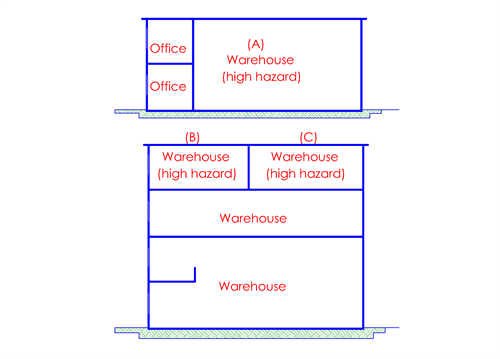
Section
Figure 3.2.7
1. Warehouse compartments A, B & C, as shown in above figure, shall not exceed 2000m² and 7500m³. Each compartment shall comprise one storey only. The materials to be stored in the warehouses shall exclude those listed under Cl.3.2.7c.(1) & (2).
2. Buildings with habitable height not exceeding 24m are allowed to be used for bulk storage of goods or substances of highly combustible nature, except those listed under Cl.3.2.7c.(1) & (2) However, if the above mentioned warehouse buildings exceed
the habitable height of 24m, the whole building must be protected with automatic sprinkler system. Irrespective of the building height, Cl.3.2.7a. shall
be complied with.
3. Materials as listed under Cl.3.2.7c.(1) & (2) are not allowed to be stored in any multi-storey building, regardless of the habitable height.
Amendment History
| 3.2.7 |
15 Sep 2020 |
15 Sep 2020 |
Reinstatement of past requirements |
Buildings of high hazard occupancy a. The compartment of buildings of high hazard occupancy shall not exceed one half of the sizes given in Table 3.2A and each compartment shall comprise one storey only. b. No storey of a building, the habitable height of which is more than 24m, shall be used for the bulk storage of goods or substances of highly combustible nature unless the building is provided with a sprinkler system to comply with Chapter 6. c. The type of storage materials or substances shall not include the following: (1) materials with an auto-ignition temperature lower than 200°C; and (2) combustible/highly flammable materials which include those highlighted in sub-clauses a., b., c. and d. of Cl.1.4.67. |
15 Sep 2020 |
Download
|
a. The compartment of buildings of high hazard occupancy shall not exceed one half of the sizes given in Table 3.2A and each compartment shall comprise one storey
only.
b. No storey of a building, the habitable height of which is more than 24m, shall be used for the bulk storage of goods or substances of highly combustible nature unless the building is provided with a sprinkler system to comply with Chapter 6.
c. The type of storage materials or substances shall not include the following:
(1) materials with an auto-ignition temperature lower than 200°C; and
(2) combustible/ highly flammable materials which include those highlighted in sub-clauses a., b., c. and d. of Cl.1.4.68.
d. For buildings not listed in Table 1.4A, including but not limited to buildings used for the manufacture and/ or storage of highly combustible substances and/ or flammable liquids, etc., the requirements shall be consulted with the SCDF.
3.2.8 Exemption on size limitation of compartment
R
Rationale - Clause 3.2.8
The minimum ventilation requirements stipulated for open-sided carpark are to ensure effective cross ventilation so as to minimise smoke logging in the event of a fire in the car park. The dimensions have been validated through a fire engineering study.
With effective ventilation, the compartment size limitation for a non-sprinkler protected car park can be exempted.
E
Explanations & Illustrations
Clause 3.2.8 : Exemption on size limitation of compartment
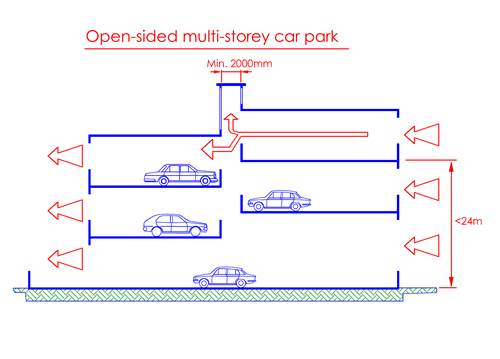
Section
Figure 3.2.8 - 1
As the habitable height is less than 24m, automatic sprinkler system is not required. The clear width of the air well shall not be less than 2000mm to prevent fire from a car from spreading vertically between split levels. Provision of fire alarm system
shall be in accordance with Table 6.3A of the Fire Code.
Openings such as grille, fixed louvre types are considered acceptable. In determining the openings for the grille, obstacle should be deducted to obtain the nett openings. As for fixed louvres, only free area should be taking into account. Provision of
sliding windows is not acceptable. The minimum 50% openings in the external walls shall be permanently open and such openings shall be evenly distributed to provide cross ventilation so as to prevent smoke logging.
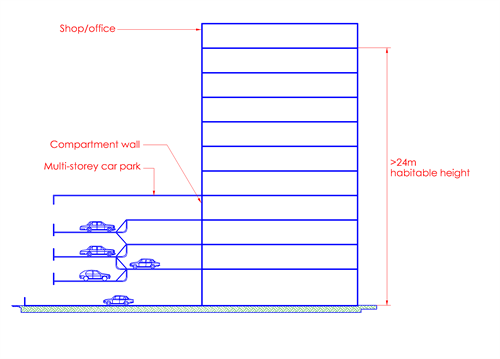
Section
Figure 3.2.8 - 2
Situation 1 – Car park is integrated with office/shop building
The attached multi-storey car park is required to be protected by sprinkler system. Cl.3.2.8a. would not apply as there is free access
between car park area and the shop/office floor area. There could be sharing of common escape staircases by occupants in the car park area and the shop/office floor area.
Situation 2 – Attached multi-storey car park is an independent building
Attached multi-storey car park would qualify for exemption on size limitation of compartment under Cl.3.2.8a., provided there is no
access opening in the continuous vertical compartment wall that separates car park building from shop/office building and no sharing of escape staircases. Each building is self-sufficient in its provision of means of escape. Multi-storey car park
shall comply fully with Cl.3.2.8a. on the provision of permanent ventilation openings for cross-ventilation.
The requirements of Cl.3.2.1 for car parking decks can be exempted if both the following are complied with:
a. The car parking decks shall be open-sided with not less than 50% of the sides permanently open and unobstructed. Such openings shall be evenly distributed along each of the perimeter walls and on every individual floor/deck, excluding perimeter walls
to air well, so as to provide cross ventilation to all parts of the car parking decks.
b. No part of the floor space shall be more than 12m from the openings on the perimeter walls of the building or air well. Air well where provided for this purpose shall have a superficial plan area of not less than 10m², or 0.1m² for every
300mm of height, whichever is greater, and have a minimum dimension on plan of 2m, open vertically to the sky for its full height.
3.2.9 Separation of area undergoing addition & alteration works
E
Explanations & Illustrations
Clause 3.2.9 : Separation of area undergoing
addition & alteration works
( No illustration )
For the benefit of clarification, the Code has introduced this clause to clarify that the separation material for spaces undergoing additions and other occupied spaces need not be fire-rated construction. Instead, non-combustible partition used for separation between the undergoing A&A works and other occupied areas shall suffice.
For additions and alterations to existing buildings, the areas undergoing such works shall be separated from other occupied areas of the building in accordance with Cl.3.15.16.
 ) or https:// as an added precaution. Share sensitive
information only on official, secure websites.
) or https:// as an added precaution. Share sensitive
information only on official, secure websites.











-1.tmb-firecode.png?Culture=en&sfvrsn=be3082c4_1)
-2.tmb-firecode.png?Culture=en&sfvrsn=e16108fe_1)
-3.tmb-firecode.png?Culture=en&sfvrsn=9c7ad0f2_1)
-4.tmb-firecode.png?Culture=en&sfvrsn=124fe5f4_1)



-(3)-1.tmb-firecode.png?Culture=en&sfvrsn=a68cb071_1)
-(3)-2.tmb-firecode.png?Culture=en&sfvrsn=310b5415_1)
-(3)-3.tmb-firecode.png?Culture=en&sfvrsn=f0cb00c3_1)
(a).tmb-firecode.png?Culture=en&sfvrsn=83a62b19_1)
(b)-1.tmb-firecode.png?Culture=en&sfvrsn=2737740e_1)
(b)-2.tmb-firecode.png?Culture=en&sfvrsn=f679ce39_1)
(b)-3.tmb-firecode.png?Culture=en&sfvrsn=44f5a53e_1)
(c)-1.tmb-firecode.png?Culture=en&sfvrsn=f31a6395_1)
(c)-2.tmb-firecode.png?Culture=en&sfvrsn=c16d5fd4_1)
(c)-3.tmb-firecode.png?Culture=en&sfvrsn=7b58a48c_1)
(d)-1.tmb-firecode.png?Culture=en&sfvrsn=98468b6e_1)
(d)-2.tmb-firecode.png?Culture=en&sfvrsn=66919709_1)
(d)-3.tmb-firecode.png?Culture=en&sfvrsn=16e9482e_1)
.tmb-firecode.png?Culture=en&sfvrsn=815f975e_1)









